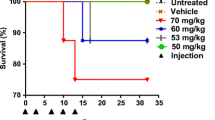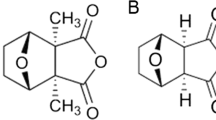Comparative study of the liver, blood, and spleen of DBA/2JSto and BALB/cJLacSto mice sensitive and resistant to acute toxicity of the cyclophosphamide allowed us to reveal basic toxicity biomarkers of this antitumor and immunosuppressive agent. Obtained results can be used for the development of an algorithm for evaluation of toxic effects of drugs and food components.
Similar content being viewed by others
References
Izotov MV, Shcherbakov VM, Devichenskii VM, Lugovaya LV, Benediktova SA, Saprin AN. Differences in the localization of active centers of cytochromes P-450 and P-448 in rat liver microsomes. Dokl. Akad. Nauk SSSR. 1986;287:1244-1248. Russian.
Telegin LYu. Pharmacogenetics of Cyclophosphamide. Moscow, 2017. Russian.
Telegin LYu, Zhirnov GF, Mazurov AV, Pevnitskii LA. Immunodepressive effect of cyclophosphamide activatedin vitro by liver microsomes from mice of different lines. Bull. Exp. Biol. Med. 1981;92(1):922-925.
Telegin LY, Pisarev VM, Pevnitsky LA. Cyclophosphamide enhances the immunosuppressive action of its own active metabolites. Doklady Biol. Sci. 2008;423(1):437-439.
Aitchison KJ, Munro J, Wright P, Smith S, Makoff AJ, Sachse C, Sham PC, Murray RM, Collier DA, Kerwin RW. Failure to respond to treatment with typical antipsychotics is not associated with CYP2D6 ultrarapid hydroxylation. Br. J. Clin. Pharmacol. 1999;48(3):388-394.
Alarcon RA. Fluorometric determination of acrolein and related compounds with m-aminophenol. Anal. Chem. 1968;40(11):1704-1708.
Andersson BS, Sadeghi T, Siciliano MJ, Legerski R, Murray D. Nucleotide excision repair genes as determinants of cellular sensitivity to cyclophosphamide analogs. Cancer Chemother. Pharmacol. 1996;38(5):406-416.
Chan KK, Hong PS, Tutsch K, Trump DL. Clinical pharmacokinetics of cyclophosphamide and metabolites with and without SR-2508. Cancer Res. 1994;54(24):6421-6429.
Hipkens JH, Struck RF, Gurtoo HL. Role of aldehyde dehydrogenase in the metabolism-dependent biological activity of cyclophosphamide. Cancer Res. 1981;41(9, Pt 1):3571-3583.
Izotov MV, Shcherbakov VM, Devichensky VM, Spiridonova SM, Lugovaja LV, Benediktova SA. The ratio of two isozyme groups in microsomal cytochrome P-450 under exogenous influence of carbon tetrachloride and cyclophosphamide. Biothechnol. Appl. Biochem. 1988;10(6):545-550.
Kato S, Ishii H, Kano S, Hagihara S, Todoroki T, Nagata S, Takahashi H, Shigeta Y, Tsuchiya M. Alcohol dehydrogenase: a new sensitive marker of hepatic centrilobular damage. Alcohol. 1985;2(1):35-38.
Nebert DW, Jorge-Nebert L, Vesell ES. Pharmacogenomics and “individualized drug therapy”: high expectations and disappointing achievements. Am. J. Pharmacogenomics. 2003;3(6):361-370.
Nordenskjöld M, Moldéus P, Lambert B. Effects of ultraviolet light and cyclophosphamide on replication and repair synthesis of DNA in isolated rat liver cells and human leukocytes coincubated with microsomes. Hereditas. 1978;89(1):1-6.
Pevnitsky LA, Telegin LY, Zhirnov GF, Mazurov AV, Viktorov VV. Sensitivity of immunodepressant action of cyclophosphamide: analysis of interstrain differences in mice. Int. J. Immunopharmacol. 1985;7(6):875-880.
Pinto N, Ludeman SM, Dolan ME. Drug focus: Pharmacogenetic studies related to cyclophosphamide-based therapy. Pharmacogenomics. 2009;10(12):1897-1903.
Schlenke P, Kisro J, Deeken M, Zajac S, Klich S, Wagner T. The cytotoxicity of mafosfamide on G-CSF mobilized hematopoietic progenitors is reduced by SH groups of albumin — implications for further purging strategies. Bone Marrow Transplant. 1999;23(2):157-161.
Takizawa D, Kakizaki S, Horiguchi N, Tojima H, Yamazaki Y, Ichikawa T, Sato K, Mori M. Histone deacetylase inhibitors induce cytochrome P450 2B by activating nuclear receptor constitutive androstane receptor. Drug Metab. Dispos. 2010;38(9):1493-1498.
Zhang J, Tian Q, Zhu YZ, Xu AL, Zhou SF. Reversal of resistance to oxazaphosphorines. Curr. Cancer Drug Targets. 2006;6(5):385-407.
Author information
Authors and Affiliations
Corresponding author
Additional information
Translated from Byulleten’ Eksperimental’noi Biologii i Meditsiny, Vol. 164, No. 9, pp. 302-308, September, 2017
Rights and permissions
About this article
Cite this article
Telegin, L.Y., Sarmanaev, S.K., Devichenskii, V.M. et al. Algorithm of Molecular and Biological Assessment of the Mechanisms of Sensitivity to Drug Toxicity by the Example of Cyclophosphamide. Bull Exp Biol Med 164, 324–329 (2018). https://doi.org/10.1007/s10517-018-3982-4
Received:
Published:
Issue Date:
DOI: https://doi.org/10.1007/s10517-018-3982-4




